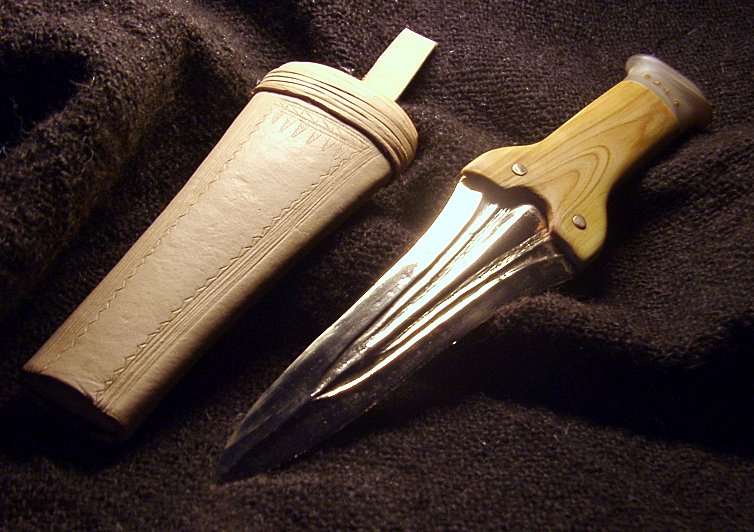Posts: 740 Location: Netherlands
Wed 27 Sep, 2006 2:38 am
Bronze age dagger reproduction
I'd like to show off one of my latest and most favourite reproductions. It's a reproduction of and Irish style bronze age dagger and scabbard. The dagger is from the period where the first daggers started to get sword lengths in Ireland and the UK (similar to this one, but stretched out greater lengths). So in that respect it belongs to the ancestors of swords in this region.
More information and photos can be found at SFI:
http://forums.swordforum.com/showthread.php?s=&threadid=72107
 Attachment: 97.88 KB
Attachment: 97.88 KB

Posts: 634 Location: UK
Wed 27 Sep, 2006 4:09 am
Very nice! Do you have any pictures of the blade before hilt assembly?
Geoff
Posts: 740 Location: Netherlands
Wed 27 Sep, 2006 4:32 am
Not of this one, but here is a photo of a blade from the same mould direct after casting:
http://1500bc.com/bronzeage/bronzes/grooved_d...2006_2.jpg
After casting, the feed, flash are removed and the blade is polished. The cutting edge is hardened by cold-working, and extra decorative lines are hammered in the first groove next to the midrib.
Posts: 250 Location: Irvine Spectrum, CA
Wed 27 Sep, 2006 9:38 am
Nice work, Jeroen. I was curious as to what historical methods would have been used to make such moulds. Was a lost wax type method used, or were both halves just chiseled/worked out to final shape? And also, how would that bronze have been obtained back then?
Posts: 5,739 Location: Wichita, Kansas
Wed 27 Sep, 2006 11:41 am
Thank you for the photo. I'm hugely intrigued by bronze age weapons and yours is a nice one.
Posts: 3,646 Location: Midwest
Wed 27 Sep, 2006 3:36 pm
It certainly looks very interesting. Especially given that we see fewer bronze reproductions.
Posts: 1,812 Location: Orlando metro area, Florida, USA
Wed 27 Sep, 2006 5:59 pm
Beautiful work, Jeroen. Your example inspires me to add another item to my "must do/have" list.
Posts: 740 Location: Netherlands
Thu 28 Sep, 2006 1:24 am
| Torsten F.H. Wilke wrote: |
| Nice work, Jeroen. |
Thanks!:)
| Quote: |
| I was curious as to what historical methods would have been used to make such moulds. Was a lost wax type method used, or were both halves just chiseled/worked out to final shape? |
In case of these daggers, the moulds were made from stone such as soapstone. So they made two flat slabs of stone (the most difficult and time consuming part!), and then carved out the shape of the dagger in mould half. The mould of a nearly identical dagger has actually been found as well. Clay mould only survive from the middle bronze age onwards, and were usually two part (sometimes with core for socketed casts), sometimes with an outer wrapping. Lost wax was probably used in the bronze age, but rarely. Instead of wax, lead was used more often for investment casting (mostly during the late bronze age).
| Quote: |
| And also, how would that bronze have been obtained back then? |
From copper and tin ores, which occur in mountainous areas, and were either mined, or dug from the surface. The tin ore is the most difficult to find, and only occurs in a few places in Europe. The smelting process is quite similar to iron smelting, though the main difference is that the metal does melt in the process, and you get a pure metal directly from the furnace. The copper and tin you melt together, and cast into the mould.
Posts: 506 Location: South Bend, IN
Thu 28 Sep, 2006 7:06 am
Great job Jeroen....
So what do you have plans for next?
If I hadn't just started a La Tene III kit this would probably have had me digging through the bronze age book section at Notre Dame.
Shane
Posts: 740 Location: Netherlands
Fri 29 Sep, 2006 3:12 am
| Shane Allee wrote: |
Great job Jeroen....
So what do you have plans for next? |
You'll find out if I have success :)
Posts: 354 Location: Dijon
Mon 02 Oct, 2006 1:04 am
Nice work, Jeroen ! I know people here who'd be interested in seeing that :) Just don't forget to bring it along next year ;)
In general, what are the proportions of the various metals in the alloy you make ?
Posts: 740 Location: Netherlands
Mon 02 Oct, 2006 11:36 am
| Fabrice Cognot wrote: |
| Nice work, Jeroen ! I know people here who'd be interested in seeing that :) Just don't forget to bring it along next year ;) |
That won't be possible, as it was part of a trade for a reproduction of a bronze age costume (on which the dagger is displayed). However, I've got several extra blades, so I can make more daggers, but I'd probably use a different combination of hilt materials.
| Quote: |
| In general, what are the proportions of the various metals in the alloy you make ? |
Generally I aim at 10-12% tin and the rest copper, unless I know the exact composition. But early bronze age pieces are usually mostly copper, and for pieces such as socketed axes I sometimes add a small %age of lead (very rarely, as I value my health!:) ).
You
cannot post new topics in this forum
You
cannot reply to topics in this forum
You
cannot edit your posts in this forum
You
cannot delete your posts in this forum
You
cannot vote in polls in this forum
You
cannot attach files in this forum
You
can download files in this forum

